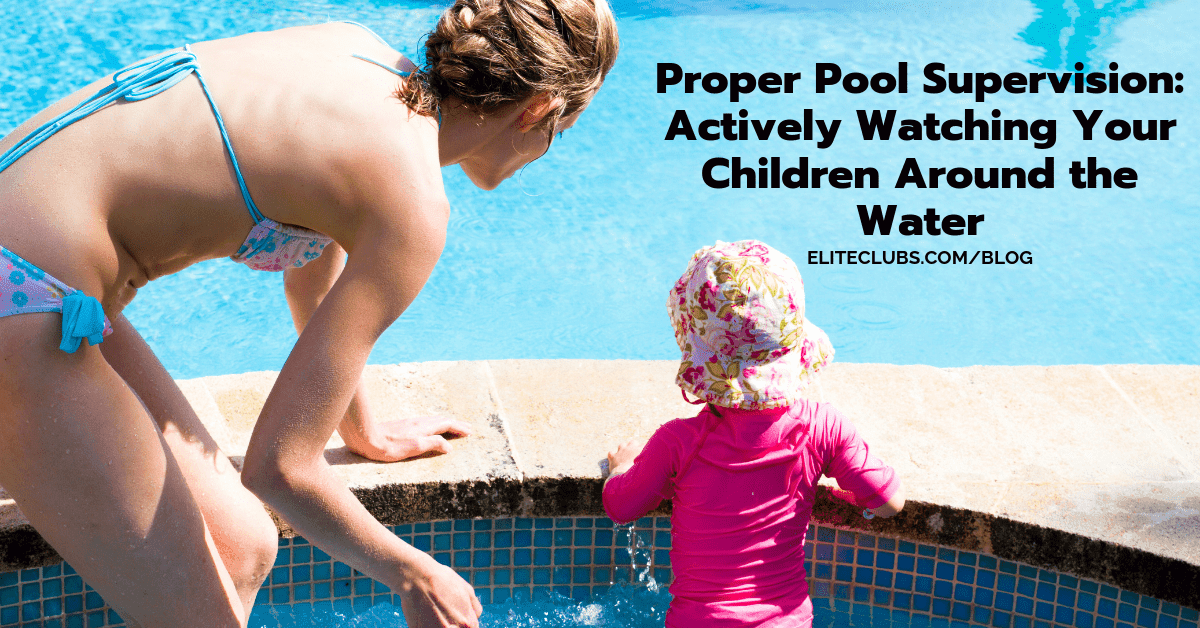
School is out, it’s warm, and sunny days call families to the water. Swimming pools and waterfronts are fun places, but they can also harbor dangers. It’s the time of year for a few reminders on properly supervising your children around the water.
Keep an Eye on Your Kids
Active adult supervision is maintaining visual contact with swimmers. Think of it as being engaged with your swimmers. Non-active supervision is not being focused on the swimmers, with close visual contact. The non-active supervisor may be reading, texting, Facebooking, emailing, or doing any number of things on a smart phone or tablet, as well as socializing, tanning, or sleeping. Talking or socializing with other adults is indicated in 18% of drownings. Recently, in Texas, a mother was criminally charged after her three children drowned while she was using her phone. Two other boys in the United Arab Emirates also recently passed away under similar circumstances. Non-active adults are unengaged with the swimmers, and not fully aware of what may be going on.
Peter Harzheim, president of the German Lifeguard Association, which staffs over 40,000 lifeguards, states: “We’re experiencing on a daily basis that people treat swimming pools like a kindergarten and simply don’t pay attention.” Most people don’t realize how quickly and quietly drowning can occur. The child is simply pushing down on the water trying to get air, and may not splash or cry out for help.”
American Red Cross Circle of Drowning Prevention
The American Red Cross Circle of Drowning Prevention includes:
- Provide close and constant attention to children you are supervising in or near water. This means no device distractions, long conversations with others, or walking away to attend to other duties. Supervising adults should avoid alcohol and drug use while they are in charge of watching children.
- Fence pools and spas with adequate barriers, including four-sided fencing.
- Learn swimming and water-safety survival skills. Enroll yourself and your children in swim lessons until both you and they are competent swimmers.
- Children and inexperienced swimmers and boaters should wear properly-fitten US Coast Guard-approved lifejackets. Lifejackets are not a substitute for active supervision, however. Any child in a lifejacket should be no more than an arm’s length away from an adult, at all times.
- Always swim in a lifeguarded area. Lifeguards are not substitutes for parental/guardian supervision, however. Lifeguards are the last line of defense in an emergency, and they are responsible for an entire pool area. Only a parent/guardian is in a position to specifically pay complete attention to their own child.
Practice Proper Pool Supervision
All adults need their own time to relax or have adult-level socialization time. If you want to do it at the pool or waterfront, please use childcare services, share supervision responsibilities with another parent, or bring a babysitter along with you to help watch your child. If you bring your children swimming, be prepared to put the devices down and pay complete attention to your children. In fact, better yet, get in the water with them – it’s good for you and them, and they are only young once. Enjoy your time with them while you have it! For additional swimming safety tips, check out this blog.
Want to have greater peace of mind when your child gets in the water? We have multiple levels of swimming lessons, including Parent & Child, Group, and Private lessons! Sign up today!
Sign Up for Swim Lessons!
Written by Jessica Heller, Aquatics Director at Elite Sports Club-Mequon
Jessica Heller has a B.S. in Biological Sciences, minor in Spanish (UW-Milwaukee, 1999), Doctor of Chiropractic (Northwestern Health Sciences University, 2002), and post-graduate continuing education focused mostly on rehabilitative exercise, sports injuries, and nutrition. She is a certified Water Safety Instructor (since 1996), Lifeguard/CPR/First Aid Instructor (since 2010), Red Cross Babysitting Instructor (since 2015), Certified Pool Operator (since 2013), Certified Strength and Conditioning Specialist (since 2006), Aquatic Exercise Association Aquatic Fitness Professional (since 2008), and Arthritis Foundation Aquatics Program Instructor (since 2011).